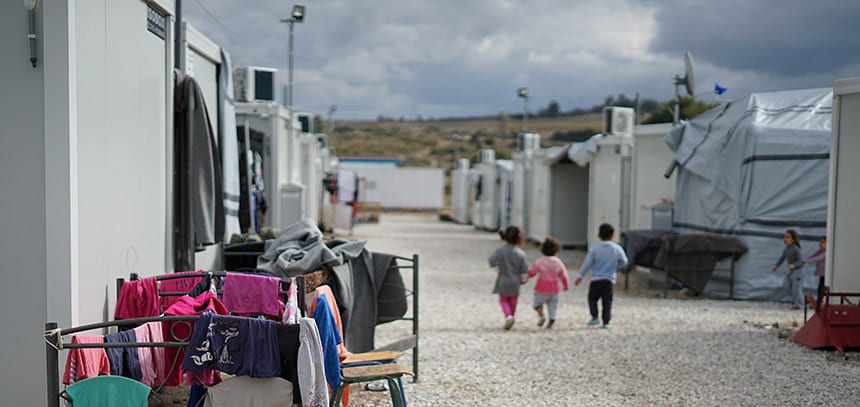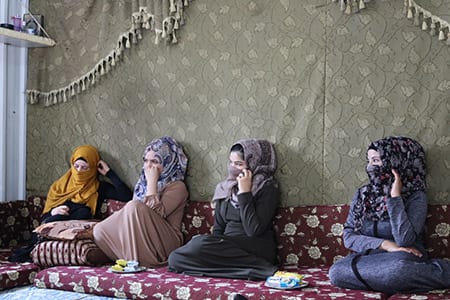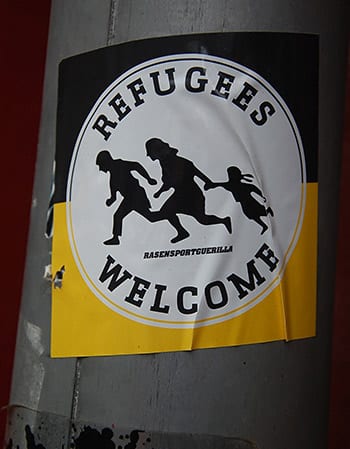Faculty Members Share Research Findings and Insights Leading Into World Refugee Day

With an estimated 80 million refugees and displaced people facing increased uncertainty and growing crises, this year’s World Refugee Day on June 20 carries added significance.
That urgency is evident at Berkeley Law. Faculty lead seminal research and often coordinate their efforts through the Berkeley Interdisciplinary Migration Initiative, clinics provide vital legal assistance, centers and institutes offer robust programming, and student groups such as the International Refugee Assistance Project advocate for rights and protections.
For its recent spring symposium, the California Law Review chose “Sharing Responsibility for Refugees” as the topic and will publish a special volume on the event in April 2022.
With the United States, European Union, and United Nations all involved in policy discussions for how to navigate growing refugee challenges, Berkeley Law faculty are probing vital issues and widely calling for more U.S. involvement. Below, several of them identify core concerns and convey their perspectives.
Katerina Linos: Seeking Solutions
Nearly 90% of refugees are hosted in developing states. Policymakers worldwide, including the Biden and Trump administrations, European Union, African Union, and United Nations, have implemented policies with the stated aim of sharing responsibility for refugees.
However, as Miller Institute for Global Challenges and the Law Fellow Elena Chachko and I argue in a new paper, Refugee Responsibility Sharing or Responsibility Dumping?, these policies are very different. Some solutions are progressive, if second-best options, that transfer seekers of international protection to more affluent, safe, and institutionally competent states. Others are regressive, third-best mechanisms, that in fact constitute responsibility dumping. We argue that there is much to learn from the European solidarity model, which EU member states put in place in response to large numbers of Syrian and Afghani refugees. For more, see our forthcoming essay and Just Security blog post.
Our paper will form part of the spring 2022 California Law Review symposium issue, which Professor Seth Davis and I organized to bring together leading scholars and practitioners, with the support of the Miller Institute. Read more here.
Julie Freccero & Audrey Taylor: Child Marriage in Humanitarian Crises
Our latest research with the Human Rights Center — Child Marriage in Humanitarian Crises: Girls and Parents Speak Out on Risk and Protective Factors, Decision-Making, and Solutions — provides the first-of-its-kind, youth-centered guidance on how to prevent and respond to child marriage in displacement settings. A special additional report examines the impacts of COVID-19 on marriage decision-making.

The study, co-sponsored by Save the Children and Plan International, engaged 280 girls ages 14-17 and 67 parents and caregivers from two South Sudanese refugee camps in Uganda and two Syrian urban refugee communities in Jordan. In addition to interviews, researchers employed innovative methods to engage girls, including creating art collages and holding discussions in a musical chairs-style format.
Questions explored what puts girls at risk of child marriage, what protects them from it, how decisions around child marriage are made, and what NGOs can do to prevent child marriage in humanitarian settings. Read more here.
Freccero is the director of the Human Rights Center’s Health and Human Rights Program and Taylor is a research manager at the center.
Sarah Song: Our Responsibility to Refugees
Nearly 80 million people have been forcibly displaced worldwide, including 26 million refugees and 4.2 million asylum seekers. Writing in the wake of World War II, Hannah Arendt, herself a refugee, described the plight of refugees as involving not only “the loss of their homes” but also the loss of “a right to have rights…and a right to belong to some organized community.” On the occasion of World Refugee Day (June 20), I want to reflect on our responsibility to refugees.
The immediate needs of refugees are for safety and the protection of their human rights, but refugees who cannot safely return to their countries of origin within a reasonable period of time need to be resettled and set on a path to citizenship in a new country. The UNHCR has outlined three main solutions. Read more here.
Leti Volpp: Refugees Welcome?

Along the Southern portion of the I-5 freeway in California appears a yellow sign depicting the silhouette of a man, woman, and female child in flight, captioned with text in black stating “Caution.” The sign has become an iconic symbol of different forms of migration in the United States and, unexpectedly, in Europe.
In the U.S., the sign’s clear reference is to “illegal migration,” and serves as a meme for longstanding debates about immigration there. But the sign has a different association in Germany, where the identical image was popularly paired with the text “Welcome Refugees.” Amid increased anti-refugee sentiment, groups further manipulated the image to accompany text stating “Rapefugees Not Welcome” and “Islamists Not Welcome.”
The movements and manipulations of the sign help illuminate how Central American refugees seeking asylum in the U.S. are not seen as truly refugees, but are considered fungible with “illegal immigrants” against whose presence Americans are cautioned. Tracing this image and its accompanying text shows starkly diverging understandings of human flight. Read the complete article here.
Seth Davis: Responsibility Sharing Within Borders
The 2018 Global Compact on Refugees recognized “an urgent need for more equitable sharing of the burden and responsibility for hosting and supporting the world’s refugees” across international borders. A few low- and middle-income countries in the Global South are the primary hosts of refugees, while wealthier countries in Europe and North America deliberately prevent refugees from arriving and limit how many refugees they will admit.
The global distribution of refugees across borders is unfair and unworkable. What about the distribution of responsibility within countries? Is it ever unfair and unworkable for a few communities to take responsibility for all refugees within a country? How should we think about responsibility sharing within borders?
National governments have, for example, adopted policies to distribute refugees throughout their countries. Such schemes may match refugees with communities that welcome them. Or they may make refugees’ lives much harder and may reflect and strengthen xenophobic backlash to refugees. My forthcoming work in the California Law Review takes a close look at responsibility sharing within borders as part of a just and workable refugee system.
Eric Stover: Engage or Stay Neutral?
Over the past year, I have been conducting research with Human Rights Center visiting researcher Sarah Craggs and Berkeley Law students Tiffany Deguzman ’22, Ivey Dyson ’21, Bryce Rosenbower ’21, and Helena von Nagy ’22 on the policies of international humanitarian aid organizations regarding information sharing with international justice institutions.
As part of the study, we conducted interviews with 28 respondents from humanitarian organizations, international tribunals, and United Nations commissions of inquiry and mechanisms. Using a semi-structured questionnaire, we asked our respondents whether humanitarian organizations working in refugee and migration settings might be able to find a middle ground — whereby they could uphold their legal responsibilities to protect the privacy of beneficiaries while, at the same time, sharing information of potential violations of international criminal and humanitarian law with judicial and United Nations fact-finding institutions.
While our research team is still analyzing the data, many respondents believe a middle ground can be found and that it should be grounded in the “3Cs” — building improved coordination, cooperation, and collaboration among all concerned.
Topics: Faculty News, International and Comparative, Social Justice and Public Interest
